Create Your Dream Purple Dorm Room In Few Easy Steps
Creating a cozy and personalized dorm room can be a fun yet challenging task, especially when you're trying to infuse...
We buy so you won’t have to! We earn commissions from recommended products, which fund testing new items by our team of experts. Thank you for your support!
If the plant community were to hold the Oscars event, they would likely give the Best housePlant award to Golden Pothos.
This plant has become incredibly famous; you’ll find it everywhere—in offices, building hallways, restaurants, schools, and many other places.
So, if someone gifted you this plant, or maybe you’re willing to have one, but you want to make sure it won’t die on you, you’ve chosen the right place.
Golden Pothos, also known as Epipremnum aureum, or Devil’s Ivy, is a plant that belongs to the Araceae plant family. It’s a highly popular houseplant known for its vining foliage
pothos pothos come in many shapes and sizes. Its leaves have a beautiful, unique heart shape featuring shades of green, yellow, and off-white.
as houseplant experts at thespruce.com said It’s so easy to care for plants pothos, and here’s why: First off, it can grow in both dark and bright rooms, as long as there is indirect light. It doesn’t need much watering and doesn’t consume a lot of fertilizer.
Just keep in mind, if you have pets such as cats and dogs, be aware because it can be toxic to them if ingested.
Now, keep reading to learn all about the basic and essential information, from how much water a Golden Pothos needs to fertilizer, soil, and everything else you need to know.

kahla akram is a professional home decorator, interior designer, and master gardener writer. he is also a seasoned expert horticulturist, with a wealth of experience and a string of impressive achievements. his work has been featured in a multitude of global magazines, and he operates under his highly respected brand, budge to gadget.
| Common Name | Golden Pothos,Devil’s Ivy, Devil’s Vine, |
| Scientifique Name | Epipremnum aureum |
| Plant Family | Araceae |
| Plant Type | Vine |
| Origin | South-east Asia |
| Mature Size | Up to 10 feet long, 2.5–6.2 ft. wide |
| Sun Exposure | indirect sunlight, direct sunlight |
| Soil Type | Well-drained potting mix |
| Soil pH | Neutral to slightly acidic (6.1-6.5) |
| Flower Color | Gold/Yellow, Purple/Lavender |
| Hardiness Zones | 10–12 (USDA) Zones |
| Toxicity | Toxic to humans and pets (dogs and cats) |
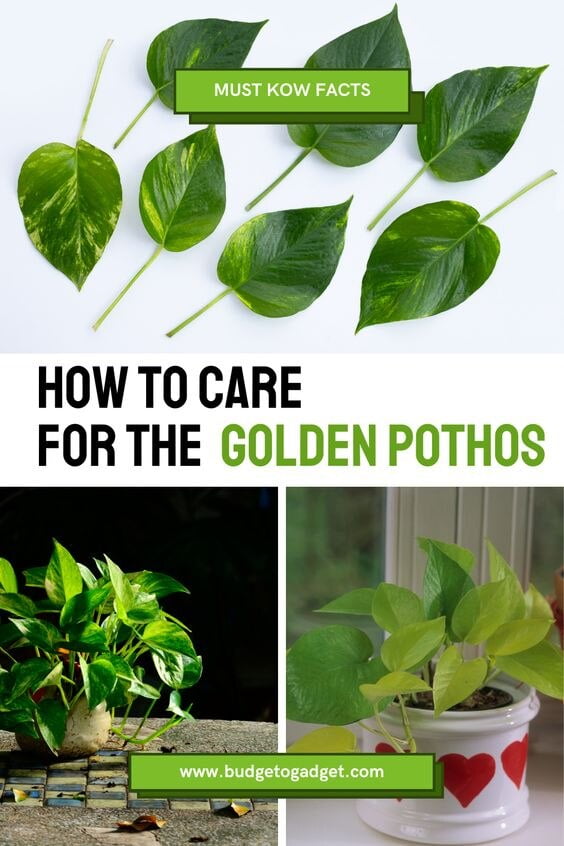
As a start, I will give you the 4 simple, short rules. Try to keep these in mind, and then I will give you the rest of how to care for epipremnum pothos.
You can use the standard potting mix as well as a well-draining soil. Surprisingly, you can even grow it directly in a jar of water; you just need to keep changing the water regularly. However, it’s best if you stick with a well-draining soil.
Golden pothos thrives best in bright indirect light. However, if you are in a north-facing home or during the winter season, Golden Pothos can tolerate medium to low light. Just keep in mind that direct light is not suitable for pothos plants, as it could cause Pothos leaf burning or browning.
When it comes to watering, you only need to water it once every week or two. Let the soil dry out completely between waterings.
pothos plant don’t need too much fertilizer. Just apply a balanced liquid houseplant fertilizer every 2 to 3 months during winter, and monthly during the growing seasons.
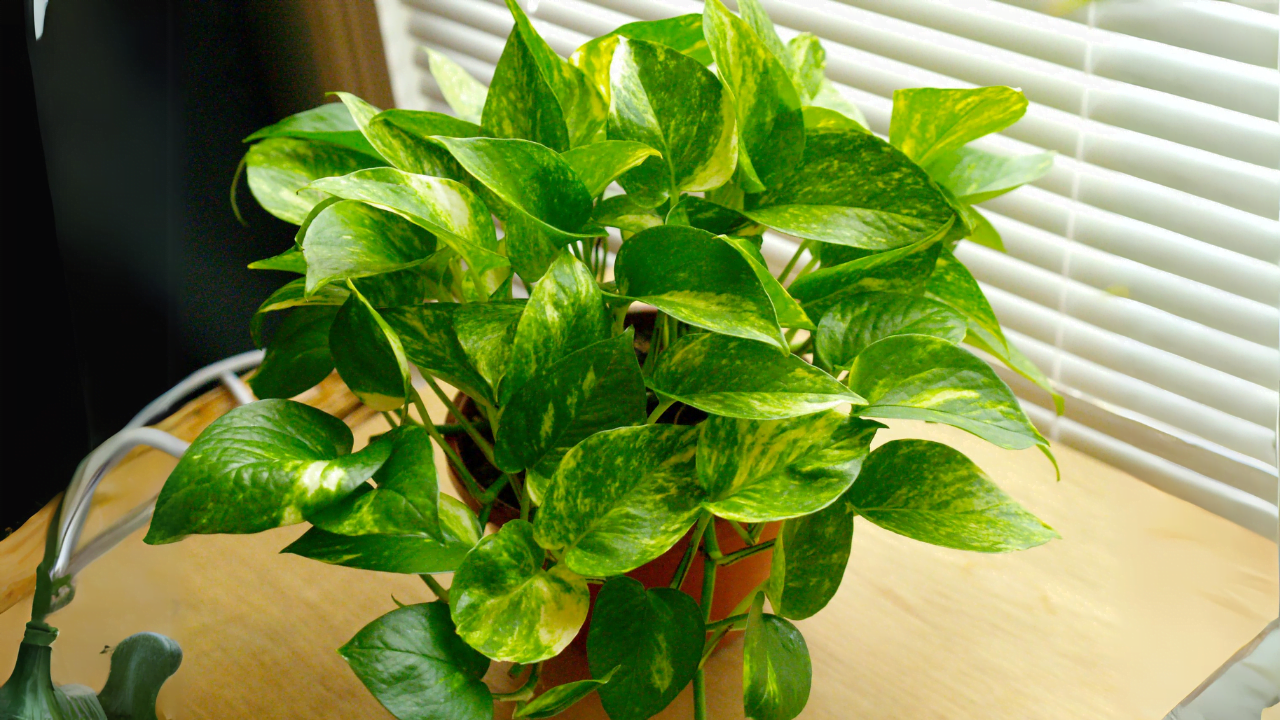
After the four basic rules I gave you, let’s get into the more in-depth, expert-level pieces of information on how to care for a pothos golden. Plus, there will be some tips I’ve found extremely beneficial as I’ve grown my pothos golden plant throughout the years.
When it comes to light, pothos plant golden love medium to low indirect light. Moreover, it thrives in bright indirect light, so it’s best to place it near an east or north-facing window.
Here’s a quick tip that I use: every time you water your Golden Pothos, try to give it a little rotation, let’s say a half turn will be fine. This act will ensure that all leaves are receiving the same amount of light.
We’ve talked about the best light for golden pothos care; now it’s time to discuss the worst light for your plant: direct sunlight. Not only will it burn your plant’s leaves and cause them to start browning, but it will also lead to a pale appearance. So, try to avoid direct sunlight.
During the growing season, giving it 30 to 40 minutes of bright light per day will help increase growth immensely.
The best soil for Golden Pothos, in short, is a well-draining potting soil that tends to be on the dry side. However, if you want the perfect Pothos soil, stick with me because I have that. But to achieve that, we need to cover four essential aspects.
Pothos plants are drought-resistant, but they completely hate soggy, overwatered soil.
Good drainage is essential to prevent overwatering and to avoid big issues such as root rot.
so adding different materials and aggregates to the potting soil such as perlite, coarse sand, clay aggregates, vermiculite, and compost can all boost airflow and water drainage for golden pothos soil.
So, the goal is to keep the soil balanced. We want it to be consistently damp but not overwatered. Therefore, I recommend adding horticultural charcoal, coco coir, peat moss, and sphagnum moss to promote moisture retention.
Pothos plants are not needy when it comes to nutrients, but like many plants, Golden Pothos will thrive better during growing seasons with a little boost. Consider adding ingredients such as compost, worm castings, mulch, manure, and biochar to provide essential nutrients for your Pothos plant to grow healthier.
Neutral to slightly acidic soil is preferred, with a pH ranging from 6.1 to 6.8.
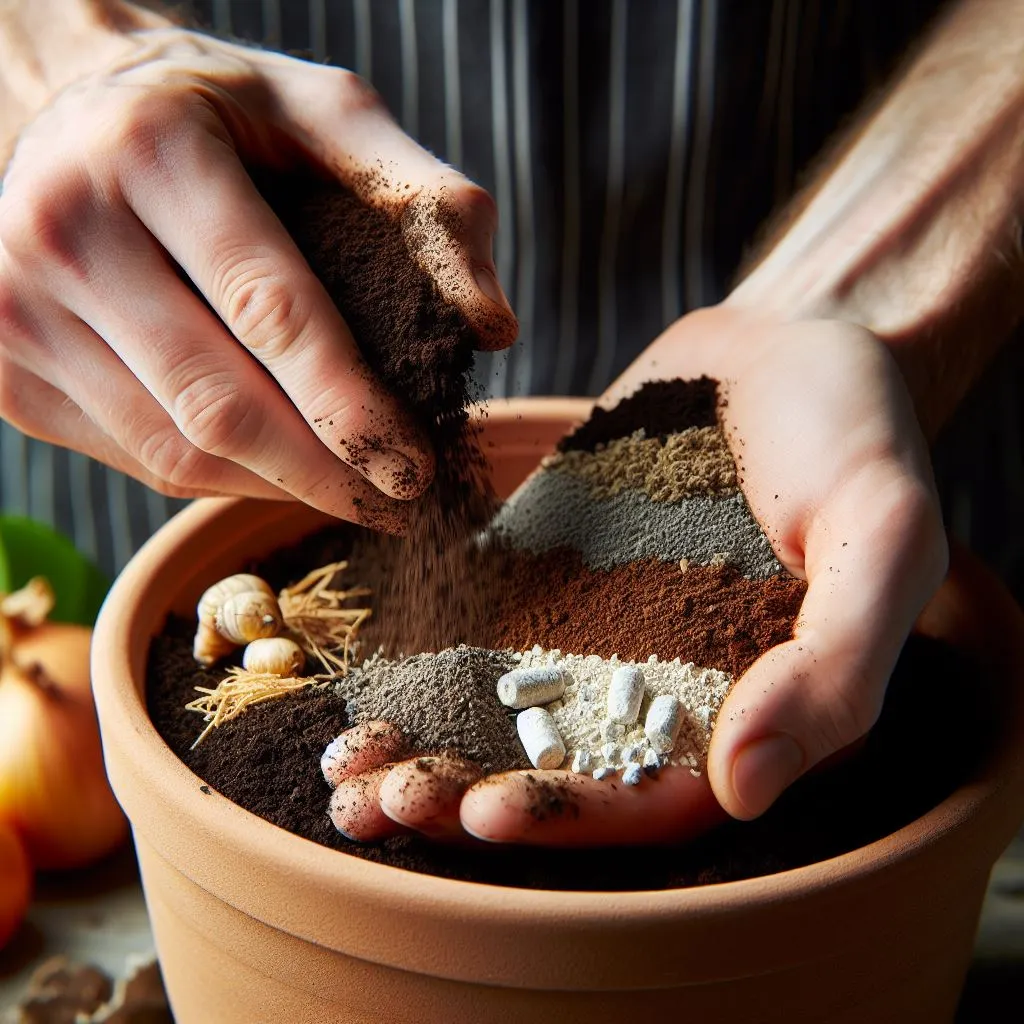
homemade Soil for Pothos plant



Pothos plants don’t need too much water. Once every couple of weeks is enough, but during the growing season, water it once a week for better growth. If your plant is in bright light, water it more frequently, and water less if it’s in a low-light place.
In the worst cases, dropping leaves is a big sign that Golden Pothos needs watering. So, try not to let it reach that level.
Another indication is dry, brown edges. This means your plant has been kept dry for too long.
To start, make sure your soil is of a high drainage type. Place an empty saucer under the pot to prevent overhydration. Next, flush the soil with either rainwater, filtered water, or bottled water for best results. Avoid using tap water directly as it contains chemicals that can harm the plant. If you only have tap water, let it rest overnight as it helps the chemicals evaporate from the water.
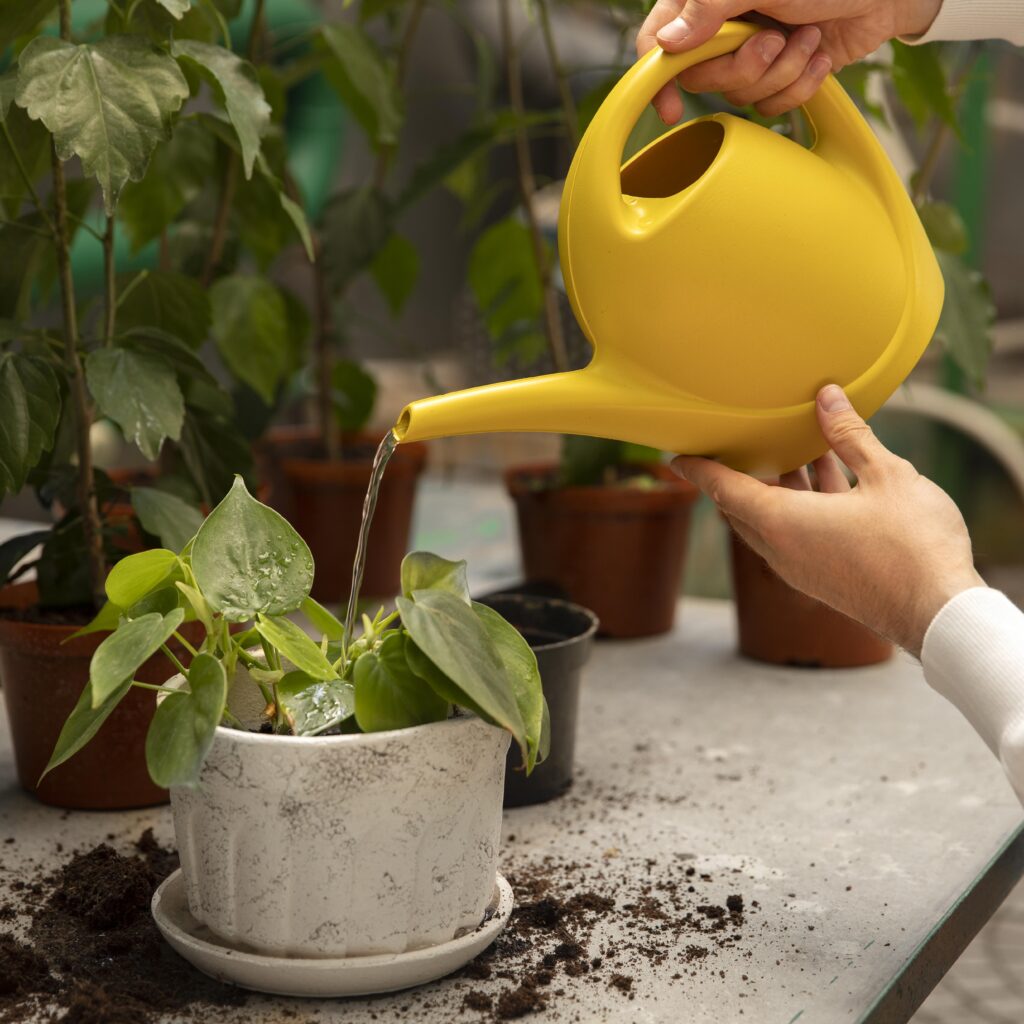
Image by Freepik
To sum up, the best temperature for Golden Pothos ranges from 60°F to 80°F (15°C to 26°C). If the temperature drops below 60°F for prolonged periods, it can harm the plant. While they can tolerate temperatures outside this range, it’s recommended to maintain the mentioned range for healthy growth.
Pothos plants are originally from Southeast Asia and thrive in high humidity levels, usually between 50% to 70%. To keep your plant happy, try to mimic these conditions by using a room humidifier or misting it occasionally, especially during dry seasons like winter. However, Pothos is generally tolerant of lower humidity levels commonly found in most households.
Golden Pothos is a light feeder, but like most plants, it can benefit from occasional fertilizing during the growing season. It’s recommended to use a balanced houseplant fertilizer (N-P-K) with ratios such as 20-20-20 or 10-10-10. Make sure to fertilize it once every 4-6 weeks during spring and summer.
There are two ways to use fertilizer: top dressing and direct application. In top dressing, all you need to do is sprinkle the fertilizer on top of the soil. You can give it a little tap to ensure it gets half an inch deeper into the top layer.
Direct application means you mix fertilizer with water, so whenever you water your plant, fertilizer will be applied. Pour it into the soil around the base and avoid touching the leaves while doing so.
After purchasing fertilizer, it’s better to follow the instructions on the package. You’ll notice that there’s a recommended amount. I always use half of that amount. Over-fertilizing Golden Queen Pothos can lead to burning roots or leaves. So, as soon as you notice that, stop using fertilizer until the symptoms start to fade.
Pruning is an essential process that every plant lover should learn, as it helps remove dead and damaged leaves that could attract diseases and pests.
Plus, it encourages new growth and maintains a fuller and lusher appearance better than a leggy Golden Pothos with few leaves.
The best time to prune not only Golden Pothos but every plant is during the growing season. Pruning Pothos in spring and summer when it’s actively growing will reduce the plant’s recovery time, which will prevent diseases from occurring.
Pruning shears: for cutting the foliage.
Gloves: to protect hands from potential irritation or cuts.
Clean cloth: for wiping down tools and potentially wiping sap or debris from the plant after pruning.

I understand that propagating a plant might seem scary to some people, as it sounds like a lot of work and uncertainty. However, believe me, it’s a piece of cake! Your first attempt might not be successful, but with time and practice, you’ll conquer the art of propagating Pothos plants.
There are two ways to propagate a Pothos plant: in potting soil or water. because Pothos, like many aroid plants, can adapt to flooding conditions.
After you notice that the roots have reached about 1 inch in length, it’s time to decide whether you want to continue growing the cuttings in water or transfer them to soil.
If you choose soil, transplant the cuttings into a potting mix. Keep the soil moist but not wet, and place the pot in indirect light conditions.
If you choose to continue propagating in water, remember that water can become murky and develop fungal growth, which is harmful to the plant. Therefore,
During the growing season, consider adding some fertilizer to promote growth.
pothos plant Propagation method by : The Hydroponics Guy



Size: Trails 6 to 10 feet, can grow longer
Color: The leaves are white with cream, silver, yellow-green, and blue-green spots.
Manjula Pothos is a mix of Marble Queen Pothos and N’Joy. It has broad heart-shaped leaves with wavy edges, unlike flat ones. Its color is mostly white with less green, which means it grows slower. To help it grow well, it’s best to put it in a bright spot.
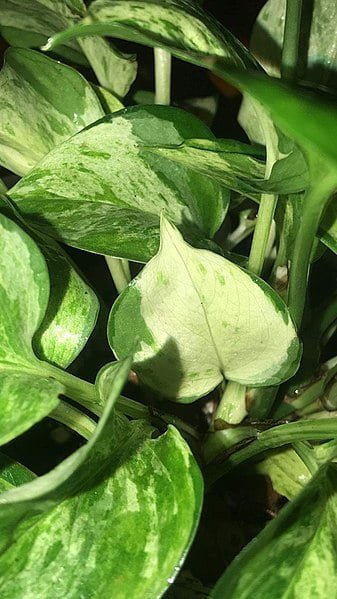
Manjula pothos │ picture By: Juliengagne18
Size: Trails up to 10 feet, up to 2 feet wide
Color: Mottled dark green with yellow and white.
Marble Queen Pothos is one of the simplest houseplants to grow. Its stunning variegated look, with more white than green, makes it stand out. It thrives in brighter spots, which helps in its growth.

Marble Queen Pothos │picture by Maja Dumat
Size: Trails up to 10 feet, up to 2 feet wide
Color: Medium to dark green
Jade Pothos is the most effortless houseplant to grow among Pothos varieties because it can handle changes in light conditions very well. It does just fine in both low and high light settings.

Jade Pothos │ picture by
Sunlit Farms
Size: Trails up 9 feet long
Color: Green centers surrounded by cream.
With heart-shaped leaves splashed with creamy white all over them, N’Joy Pothos stands as one of the most elegant Pothos plants. Its low-maintenance nature makes it suitable for beginners.
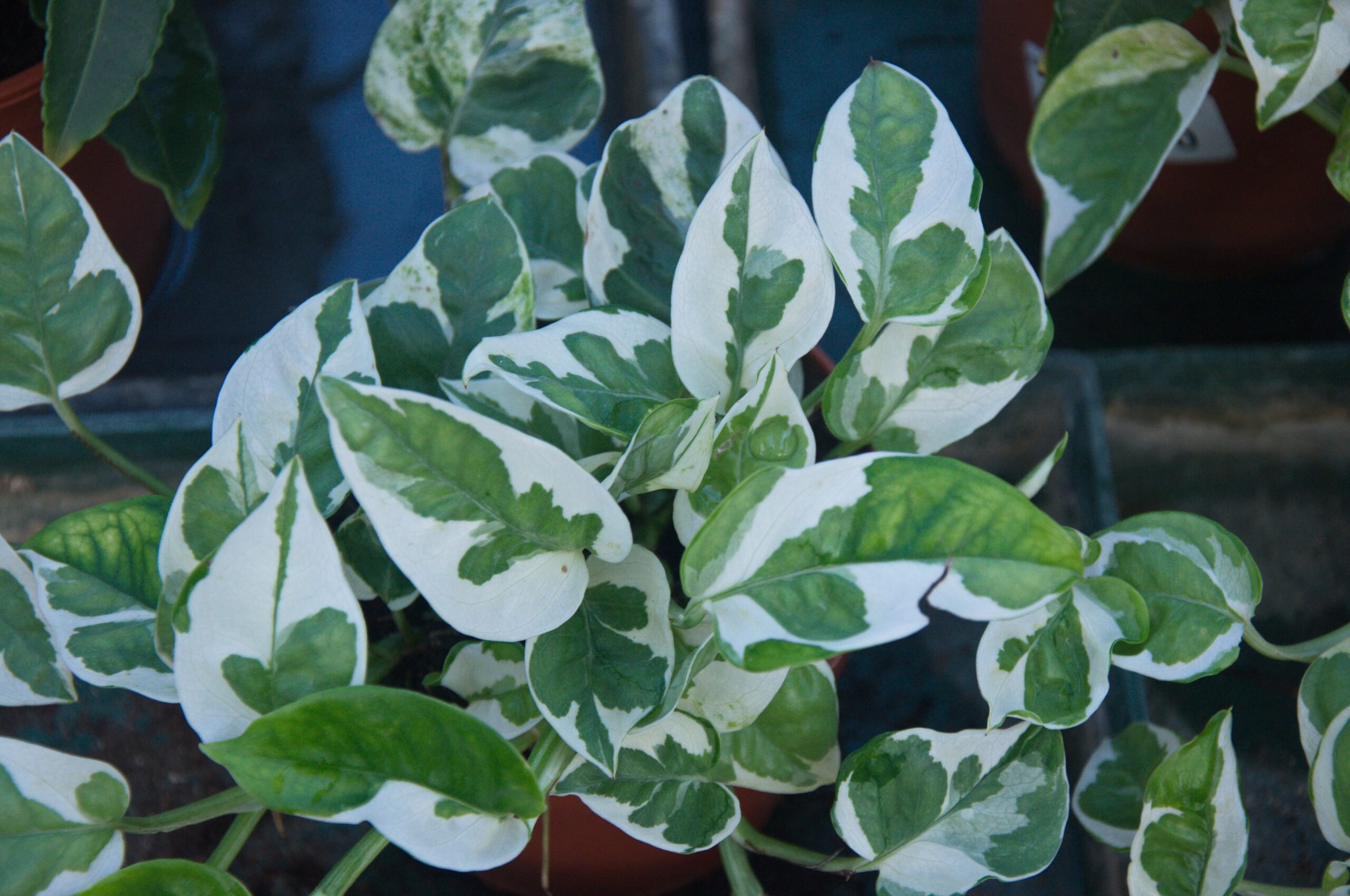
N’Joy pothos │ picture by: Stefano
Size: Trails up to 10 feet, up to 2 feet wide
Color: Blue-green foliage
Similar to other Pothos varieties, Cebu Blue is simple to maintain. Its name comes from the blue-green hue of its leaves. It prefers medium to bright indirect light and won’t do well in low-light settings.
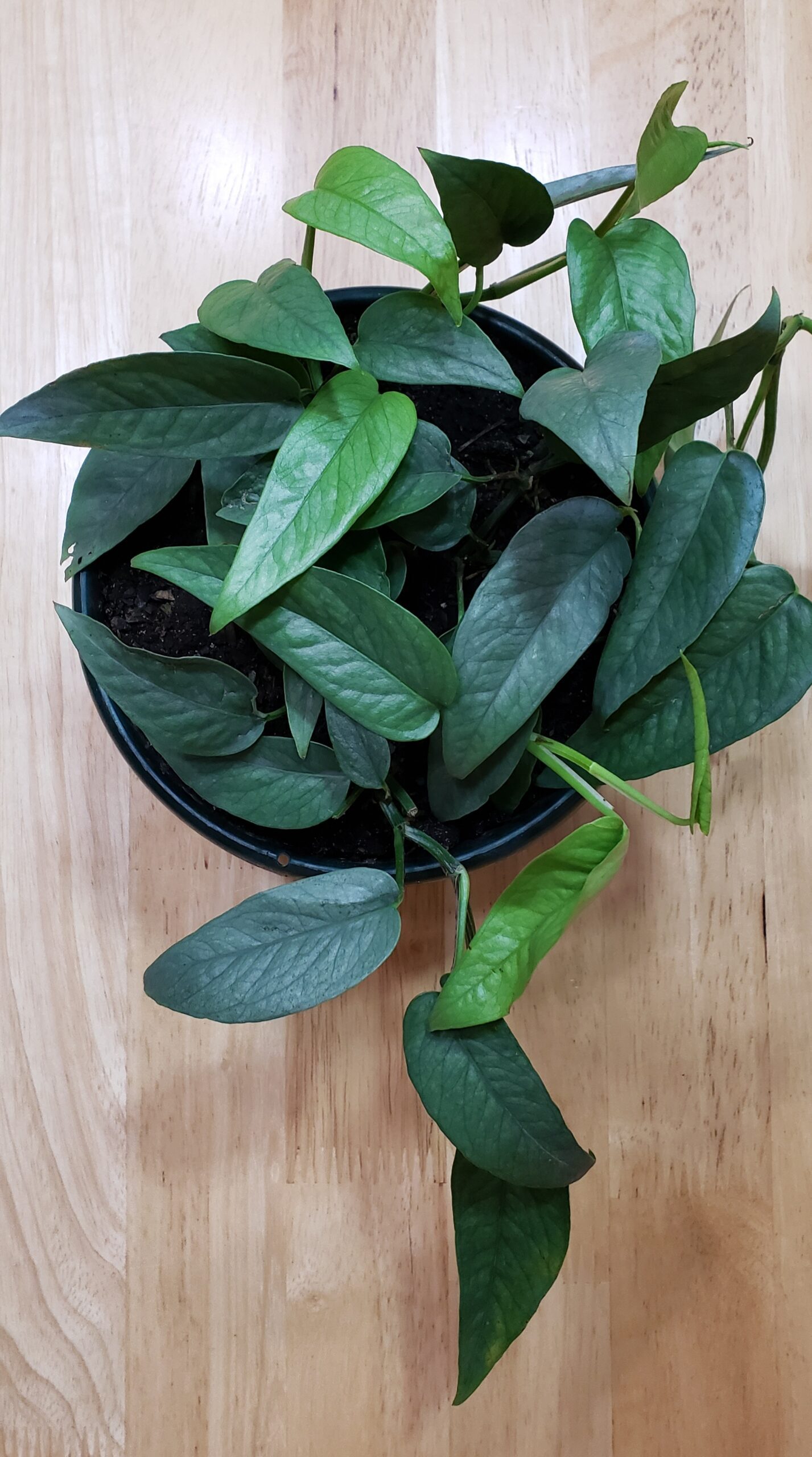
Cebu Blue Pothos │picture by MDawny72
Size: Trails 6 to 10 feet, can grow longer
Color: Foliage is chartreuse
Neon Pothos gets its name because it’s bright and great for brightening up dark spots. It looks best in medium indirect light to keep its vibrant color; too much bright light can fade its neon leaves to green.

Neon Pothos │ picture By: Quinn Dombrowski
Before repotting your Golden Pothos, make sure all the materials are ready. You will need soil mixed with good drainage and nutrient retention, a pot with drainage holes, ideally one slightly larger than the old pot, a trowel, and pruning shears.
Gently remove the Pothos plant from the current pot, using techniques like squeezing and rolling the pot to loosen it a little.
Carefully untangle the roots and try to remove as much of the old soil as possible.

Golden Pothos is susceptible to pest infestations and diseases. Here are the most common ones and how to treat each one:
This disease is caused by overwatering or the use of poorly drained soil.
Symptoms will include yellowing leaves, a lack of growth, and eventually plant death.
You can prevent this by using the recommended well-draining soil and allowing it to dry completely between waterings.
A kind of fungal disease that will cause black or brown spots to appear on your Golden Pothos leaves.
This infection is a result of overwatering or poor air circulation in your home.
So, to treat it, you need to cut off infected leaves and improve air circulation by opening the window from time to time.
A common understanding is that yellowing leaves occur because the plant is aging, but that’s not the only reason.
If your Pothos plant leaves are turning yellow, you need to ask yourself these questions: Are you overwatering it? Underwatering it? Is your plant getting enough light? Could it be lacking nutrients? If one of these factors is impacting it, it will be the cause of your problem.
Small white insects are found on leaves and stems. These insects suck sap from the plant, which can cause leaves to yellow and drop.
Tiny insects spinning webs on leaves also feed on sap and cause leaves to yellow and drop.
small hard look like a shell kind insect sucks on the sab and causes leaves to drop and yellowing

Or you can use some gnat traps. I recommend the one that Oh Happy Plants offer, or to make pest control a hassle-free process, think of investing in a cleaning kit

At Budge to Gadget, we only use reliable, up-to-date sources such as Research papers, books published by respected academic publishing houses, and articles written by well-respected authors. To support the information in our articles. Read our sourcing and fact-check process to learn more about how we fact-check and maintain our material’s accuracy, dependability, and trustworthiness.
Taking care of indoor pothos is easy! Just keep it in indirect sunlight, water it when the top inch of the soil feels dry, and trim any yellowing leaves.
Pothos can thrive in low to moderate light conditions, but it prefers indirect sunlight.
Water your pothos about once a week or when the top inch of soil feels dry to the touch.
The best houseplant for low-light apartments is the Snake Plant.
Place your pothos in a spot with indirect sunlight, like near a window with a sheer curtain or in a well-lit room away from direct sun.

kahla akram is a professional home decorator, interior designer, and master gardener writer. he is also a seasoned expert horticulturist, with a wealth of experience and a string of impressive achievements. his work has been featured in a multitude of global magazines, and he operates under his highly respected brand, budge to gadget.
Creating a cozy and personalized dorm room can be a fun yet challenging task, especially when you're trying to infuse...
You thought the last list was awesome? Well, we’ve got even more unique and out-of-the-box products that will elevate your...
If you're a flower lover like me, you know the struggle. of wanting more and more flowers, especially those puffball...
Starting college is an exciting journey filled with new experiences and challenges. One of the key aspects of settling into...
Moving into a dorm room is such an exciting time in your life! It's a space where you'll study, relax,...
Subscribe to our newsletter for the latest decoration designs, ideas, and tips. Stay connected with us!